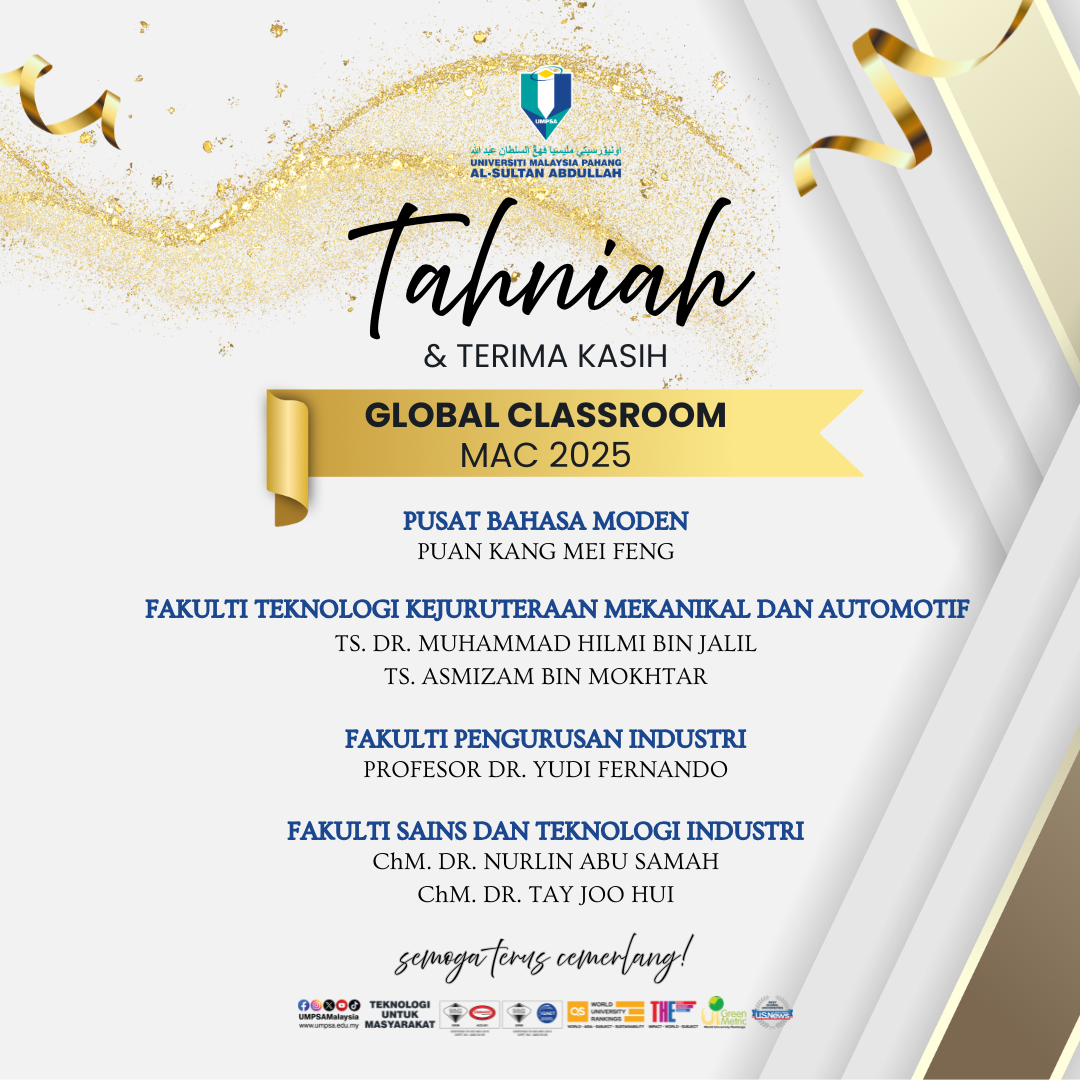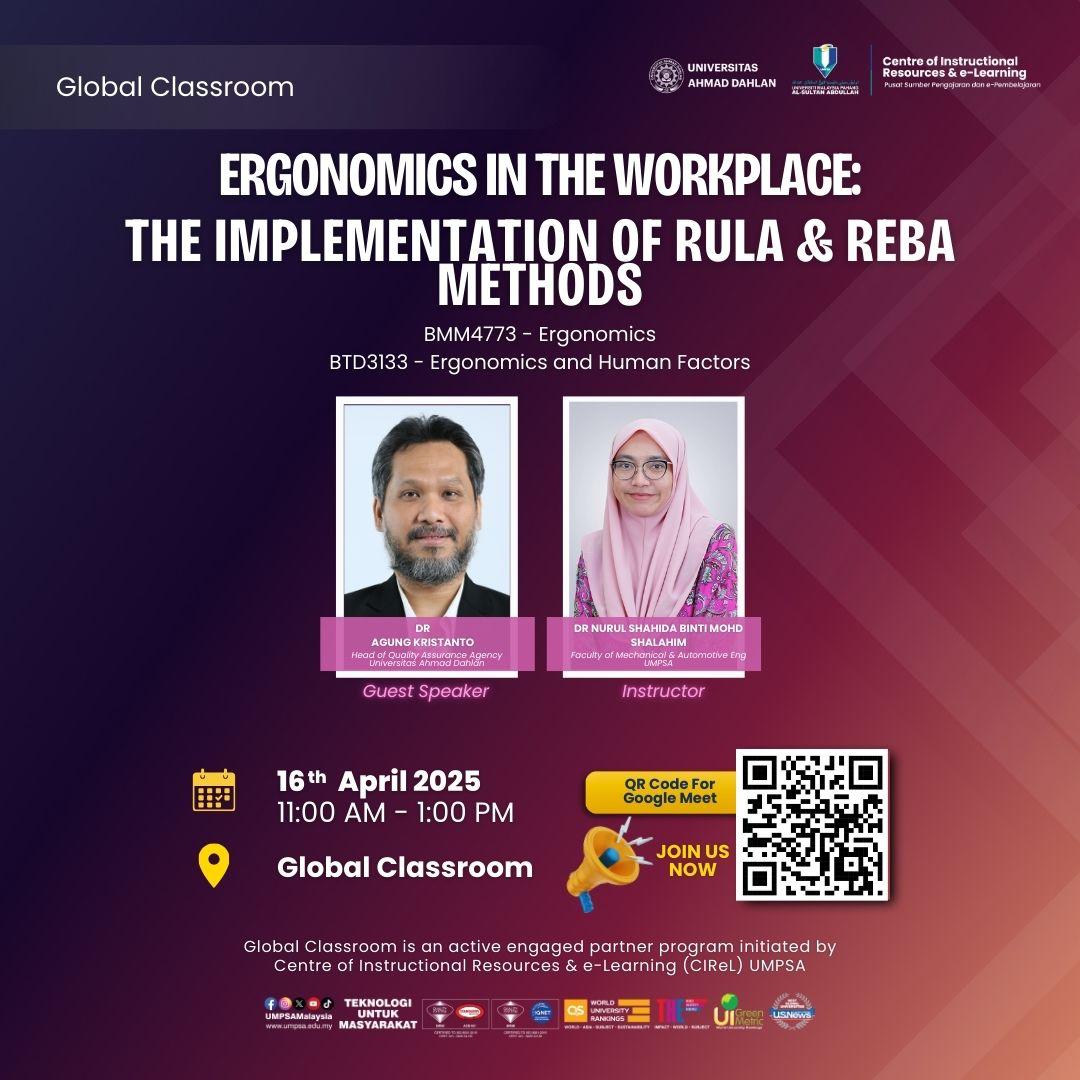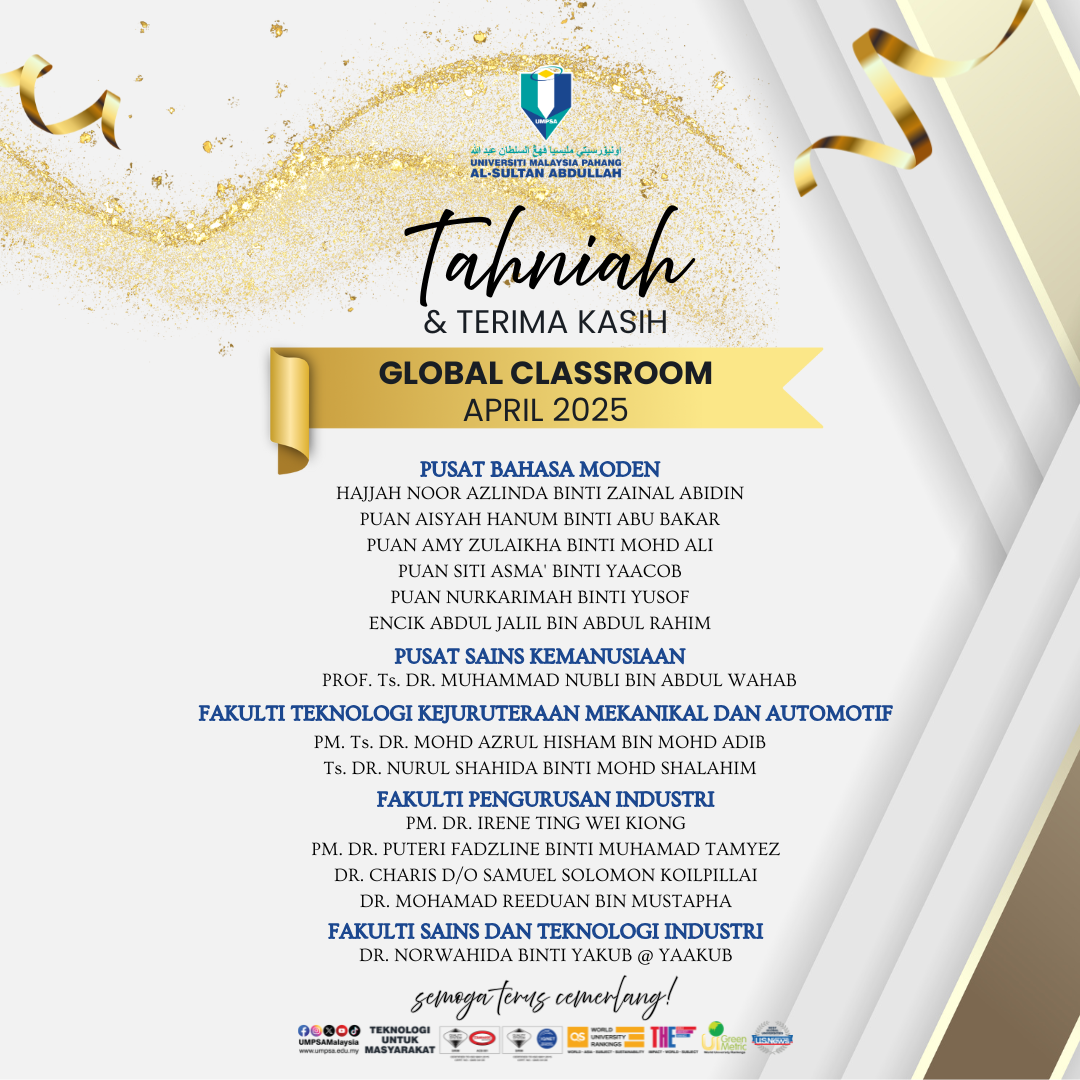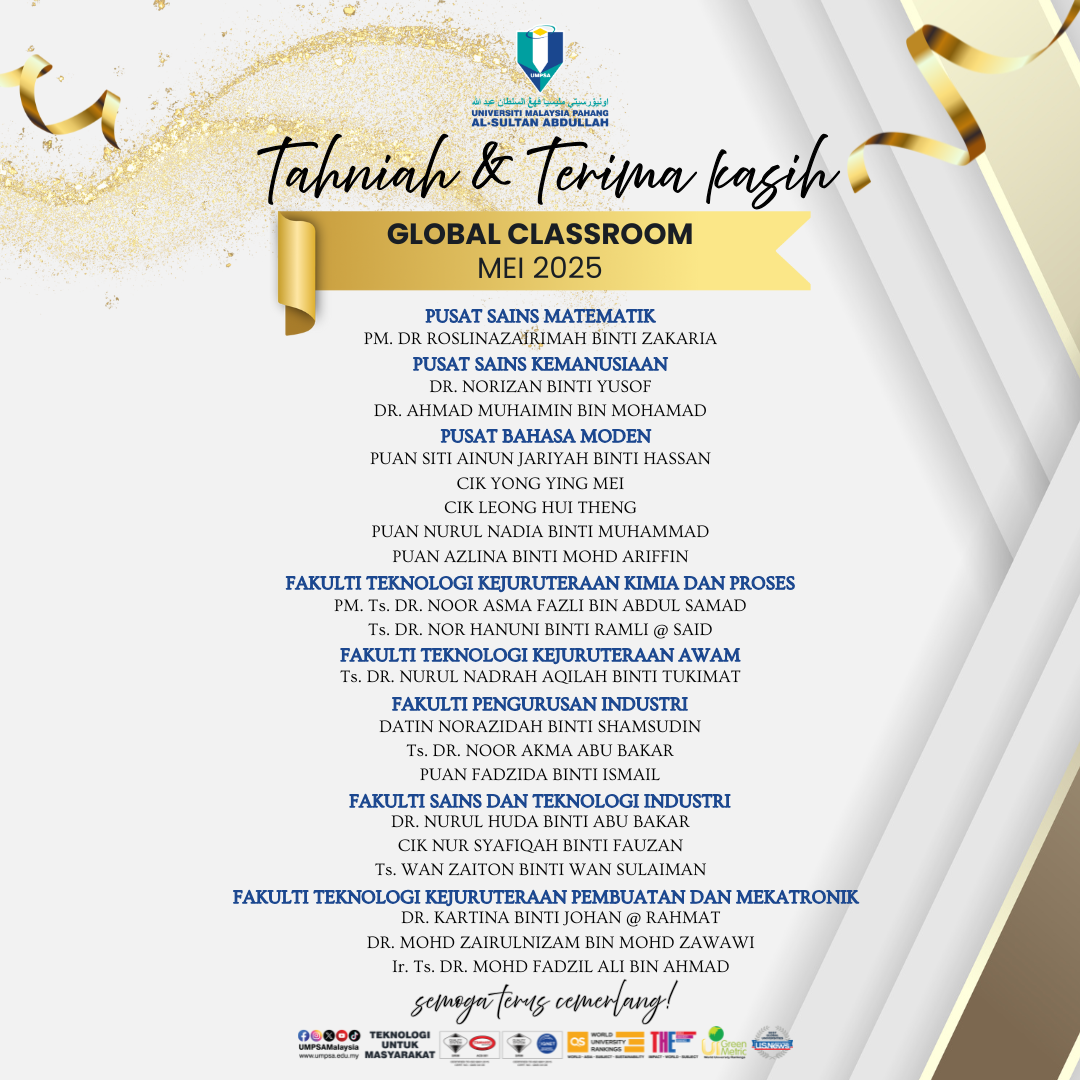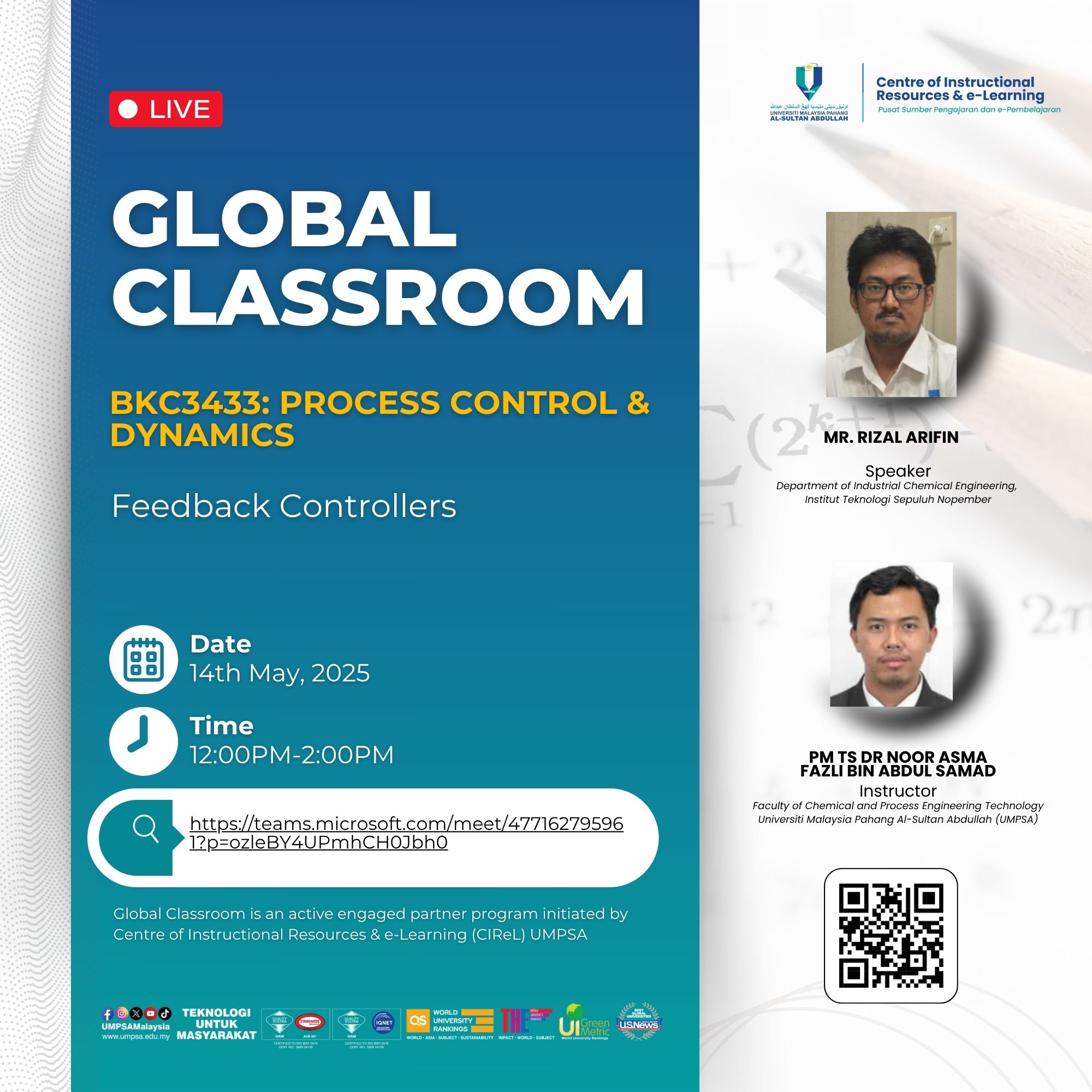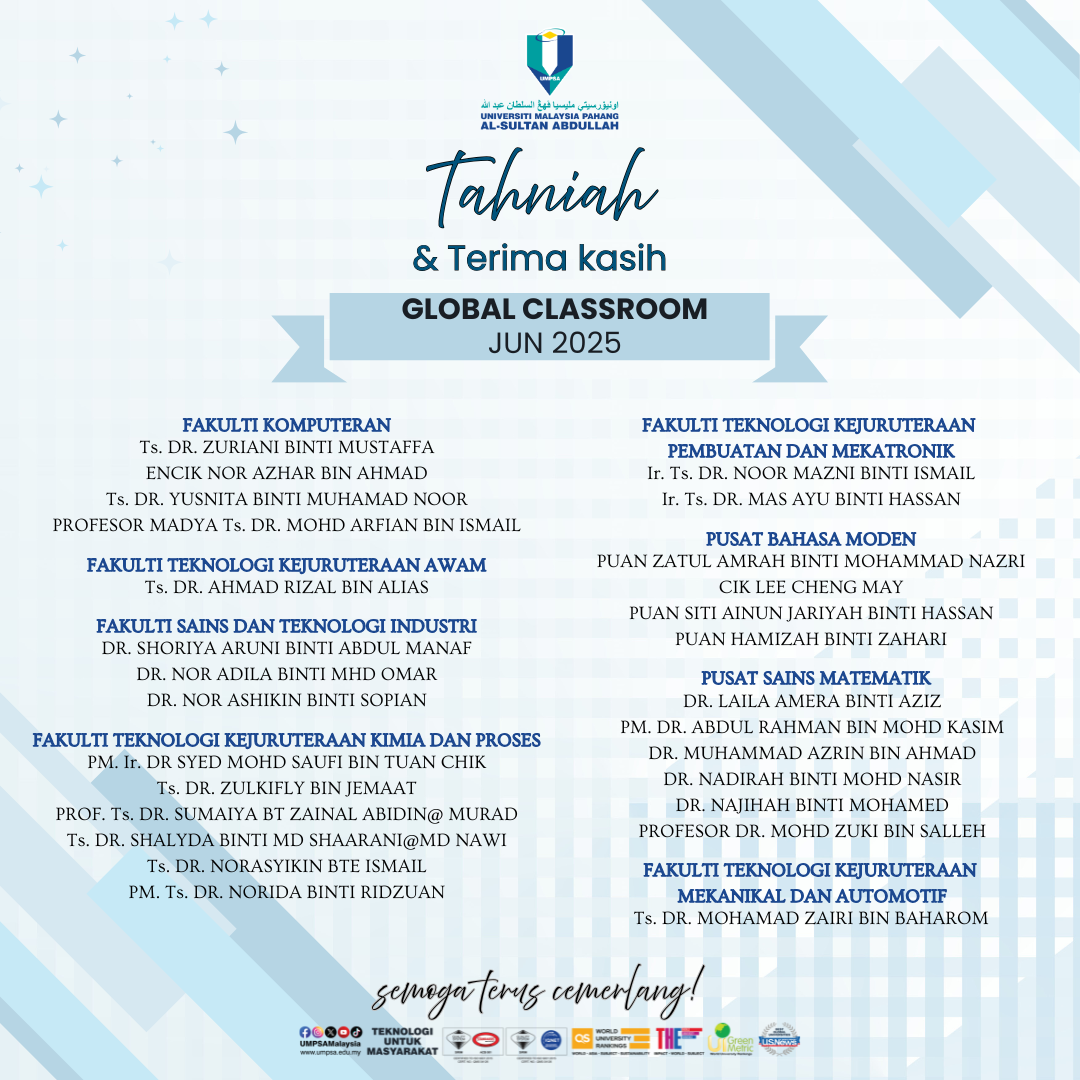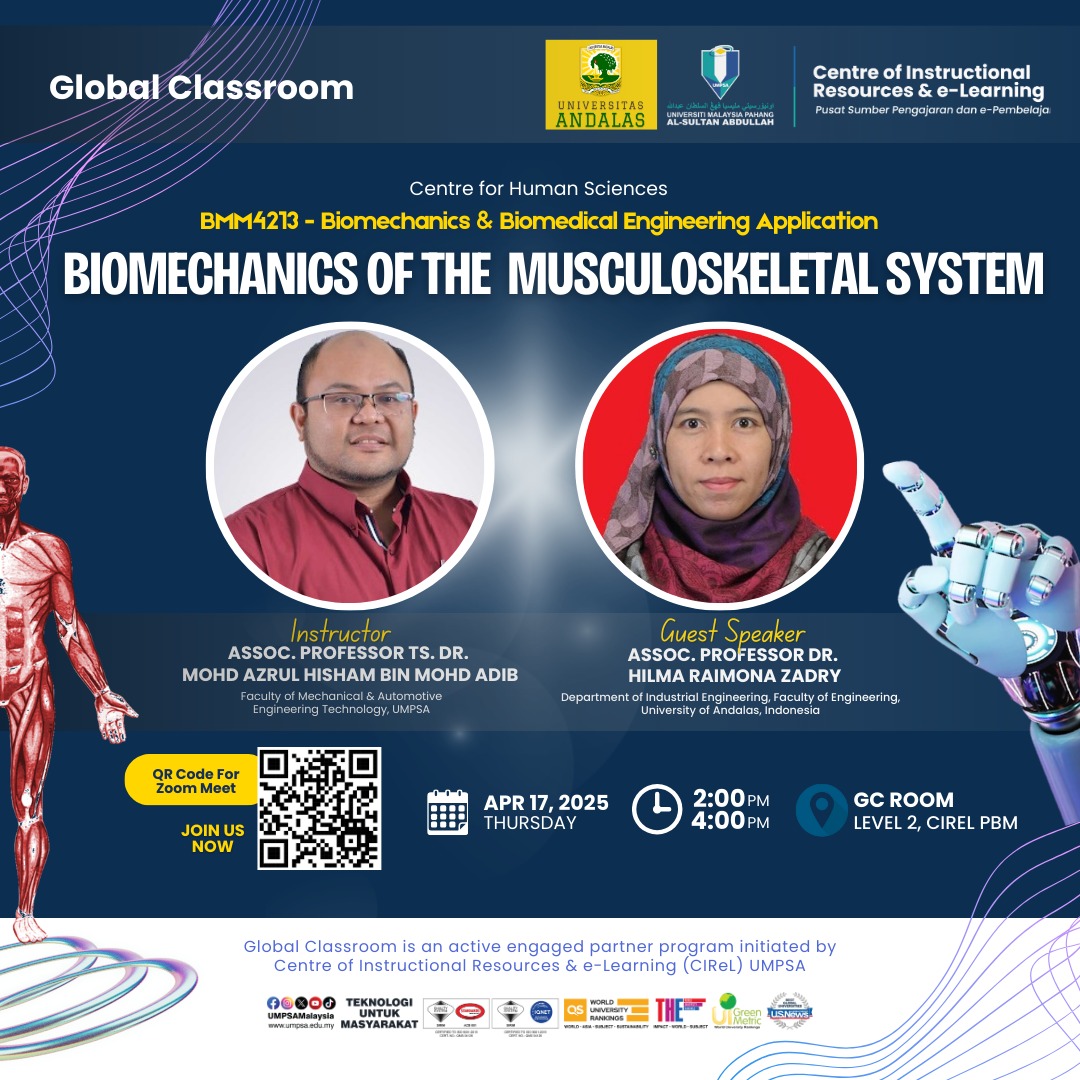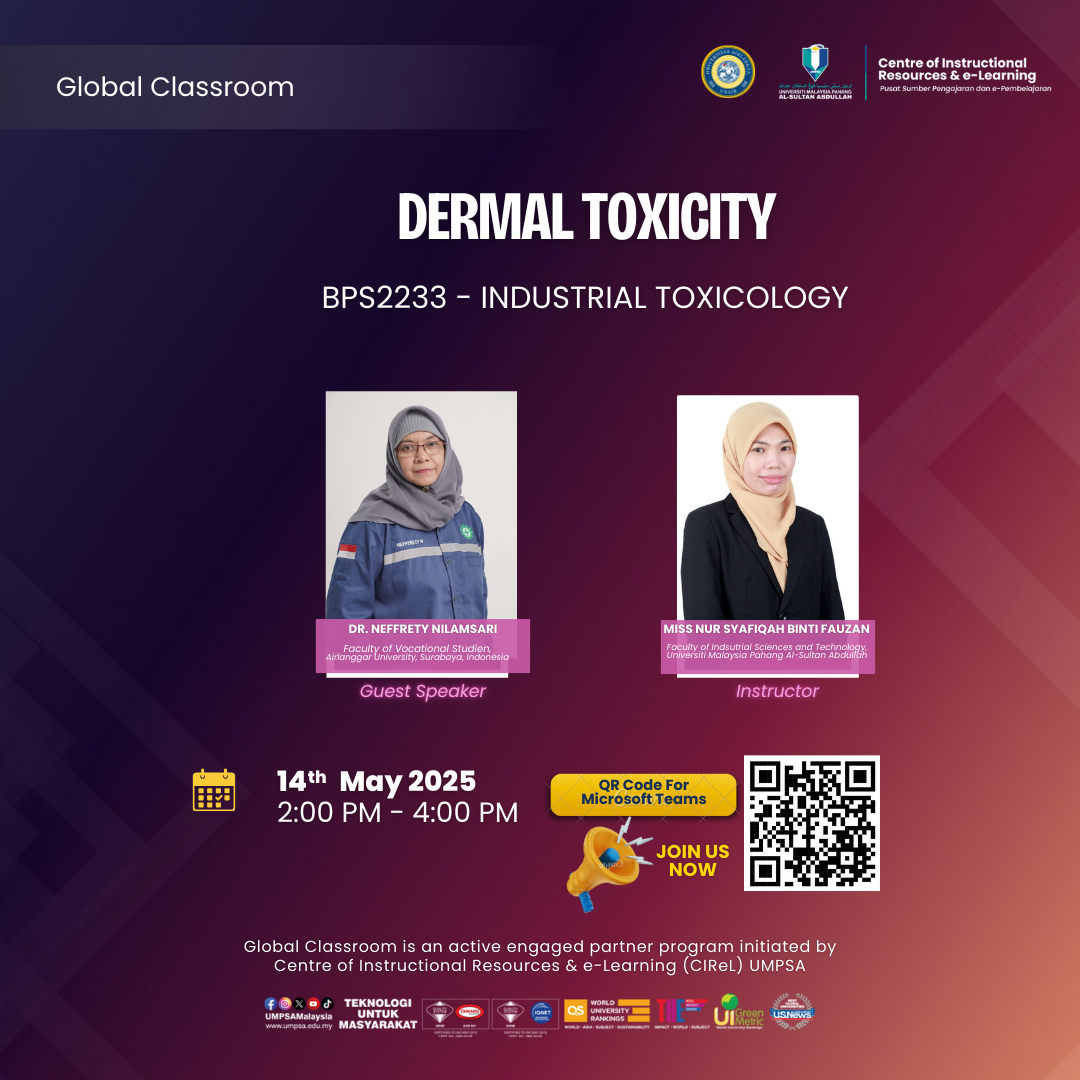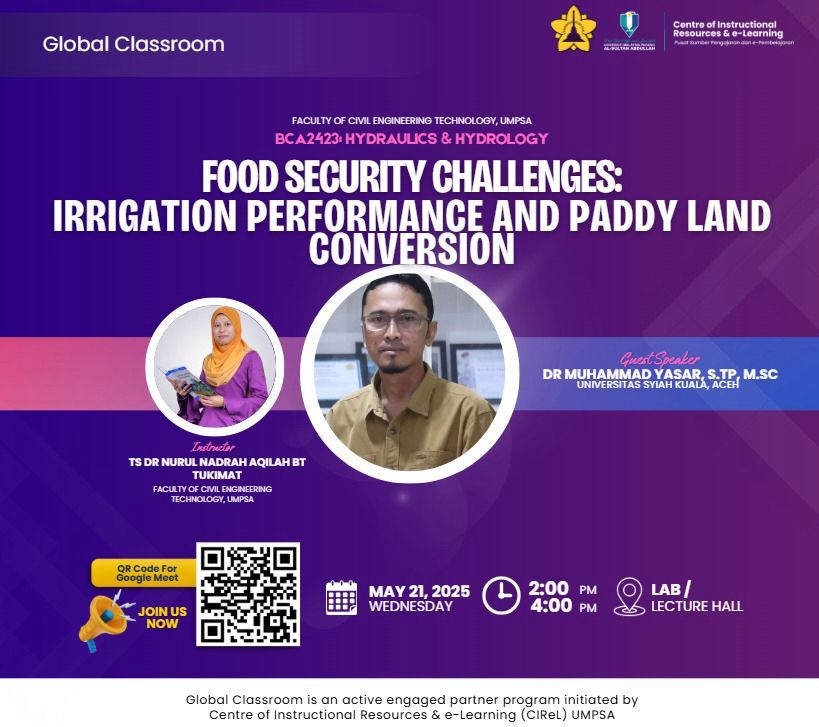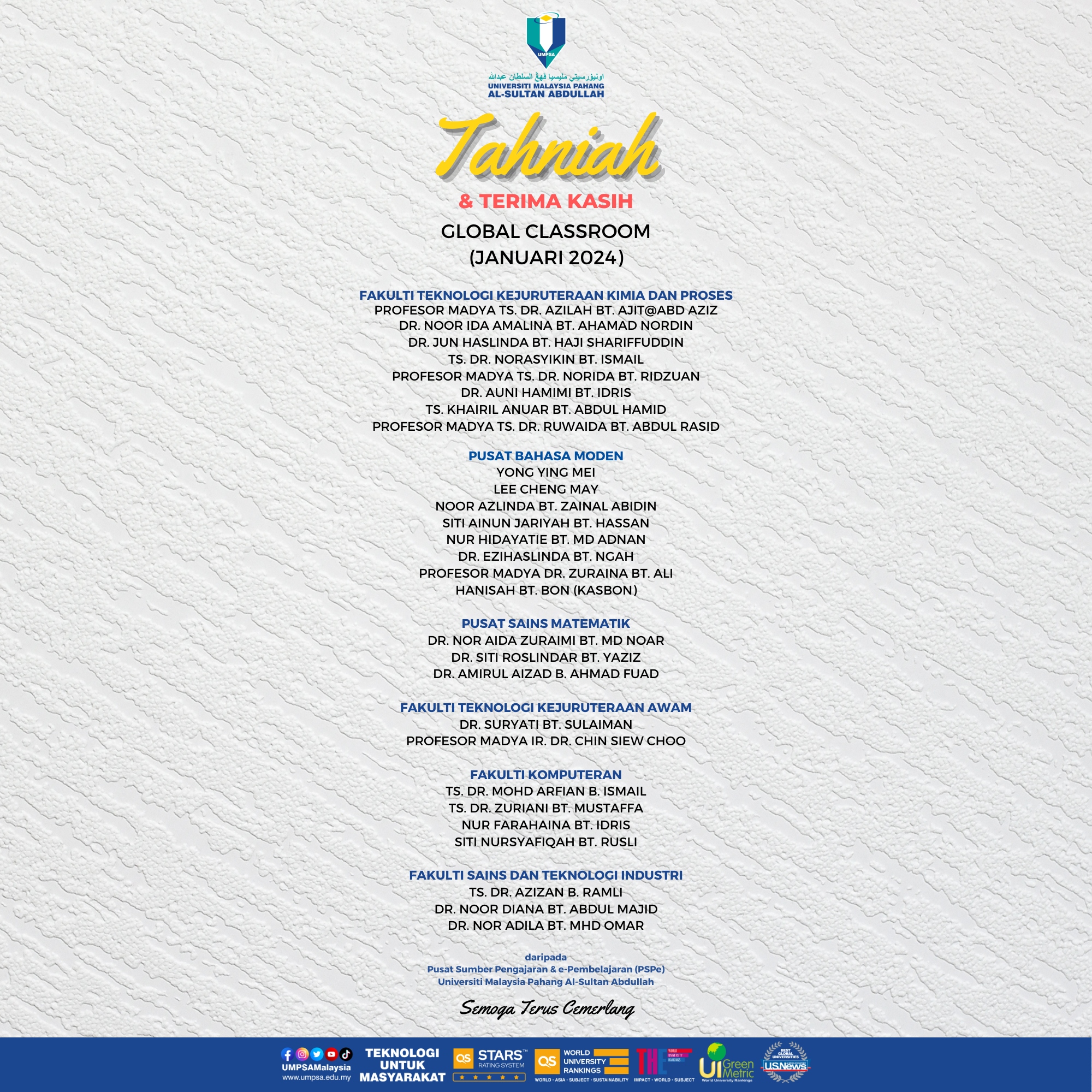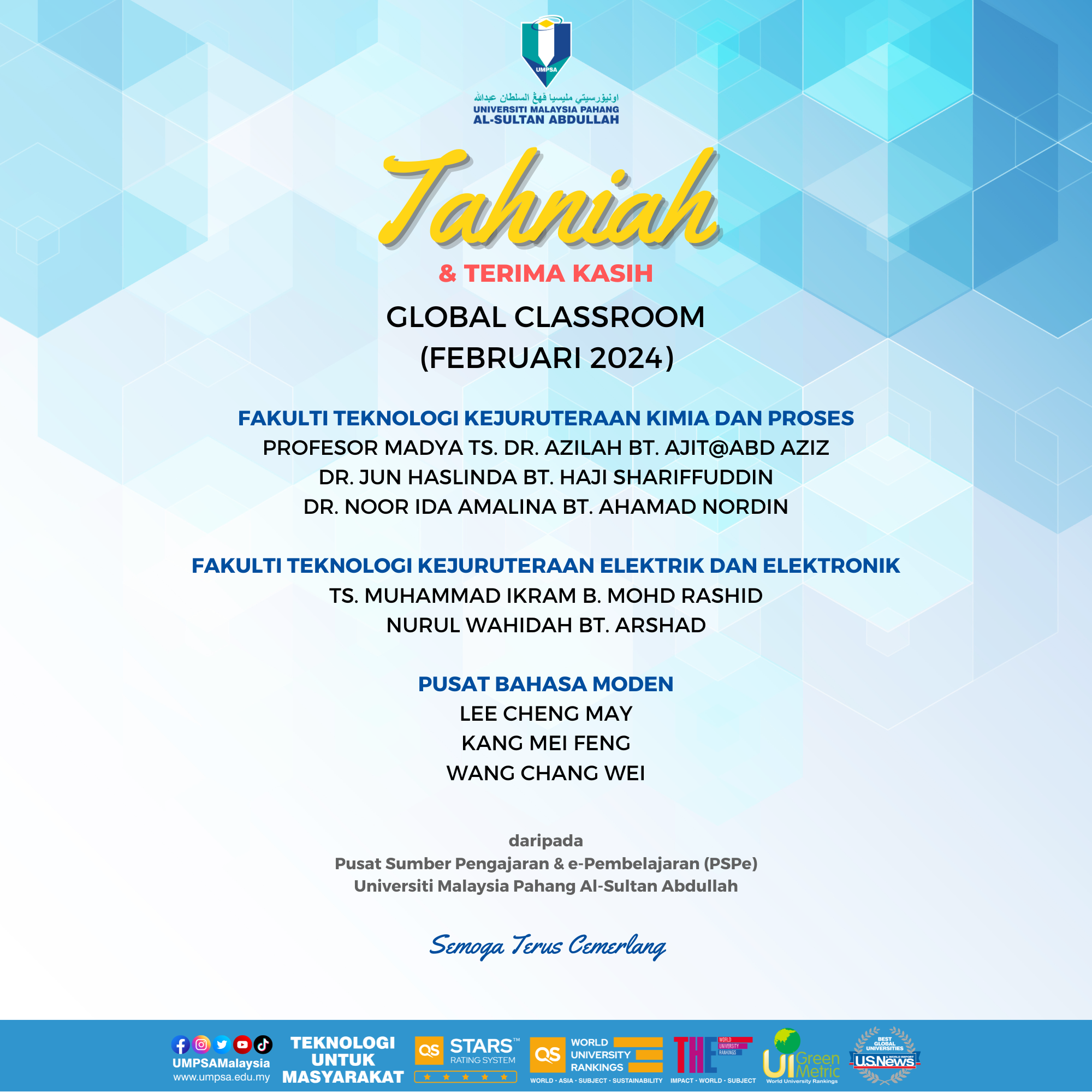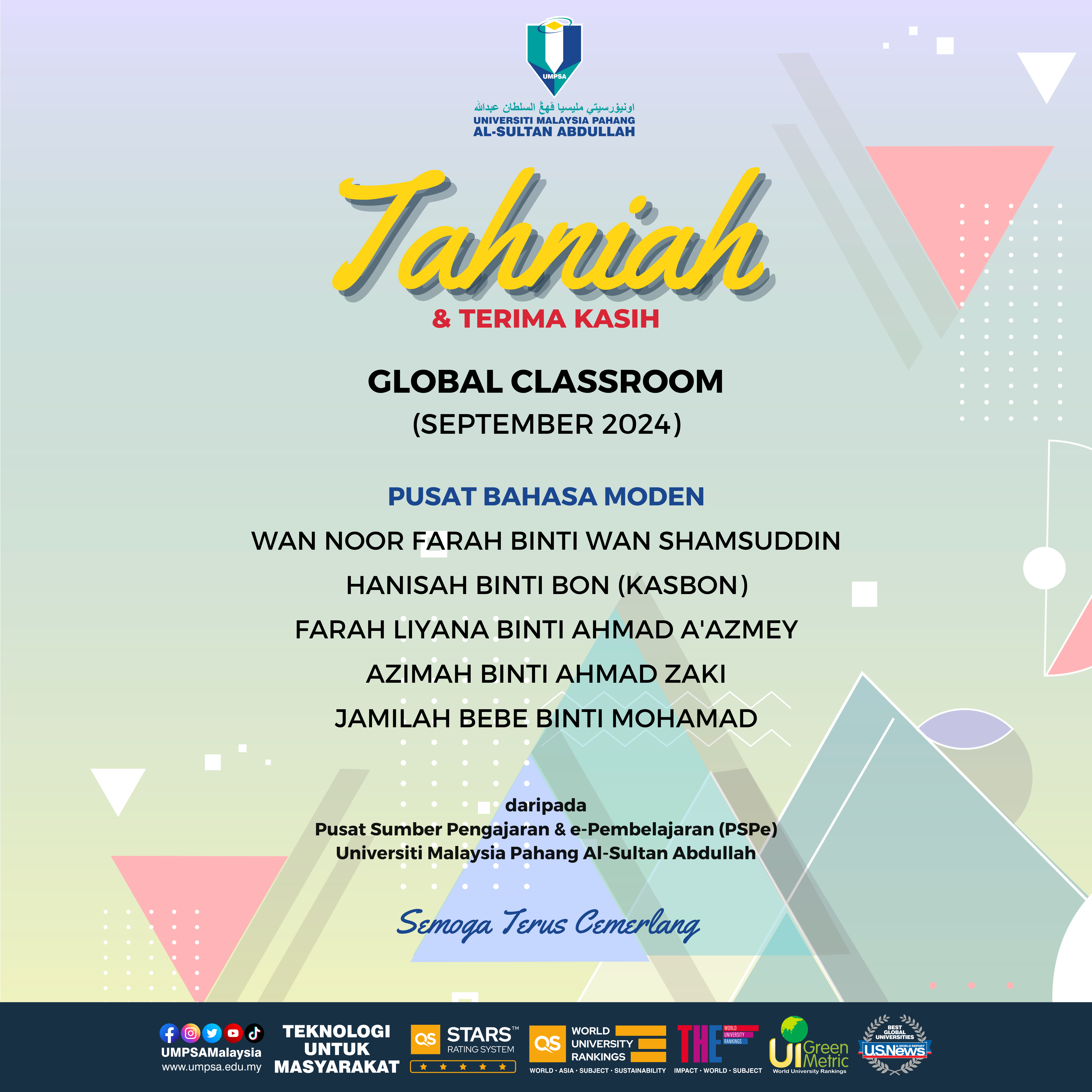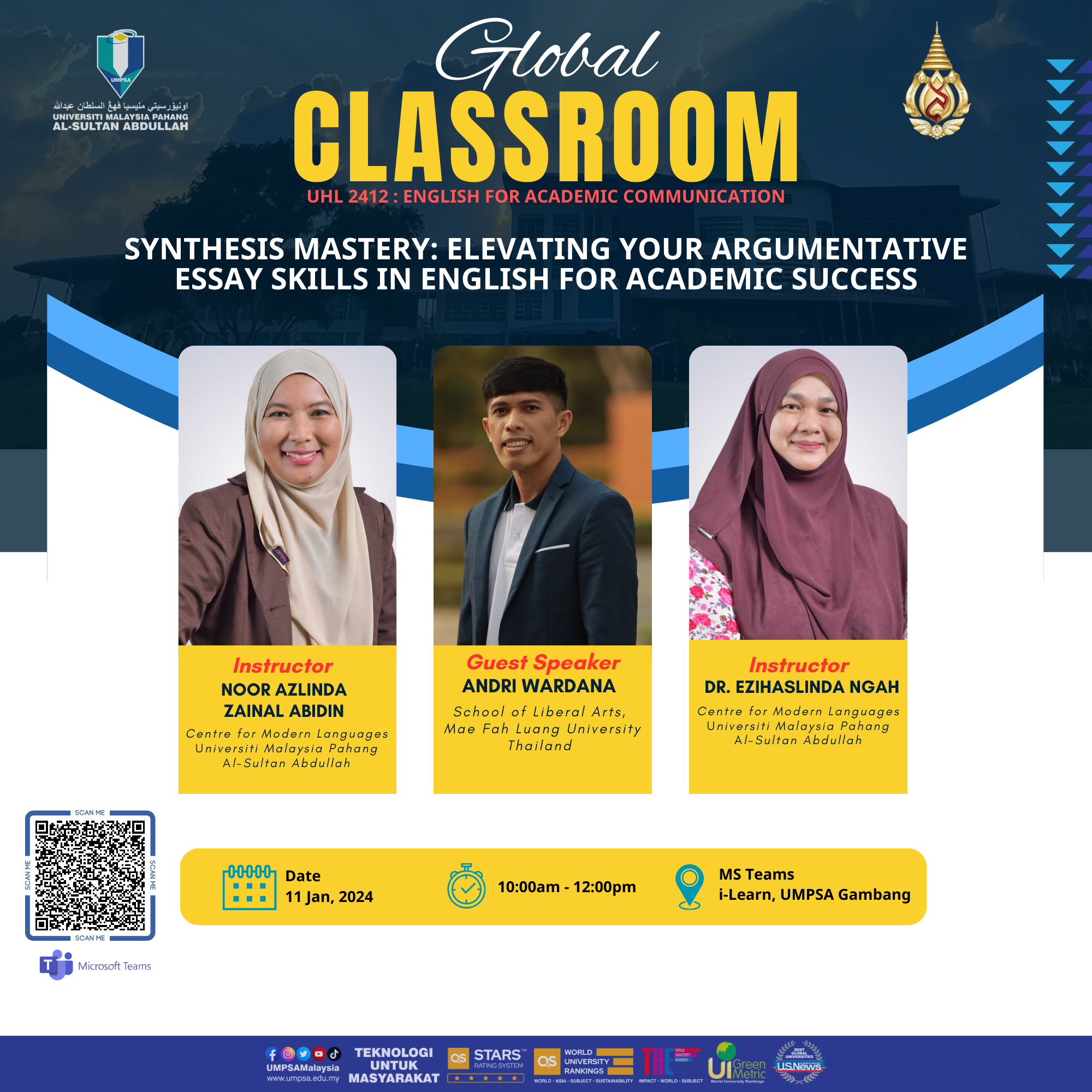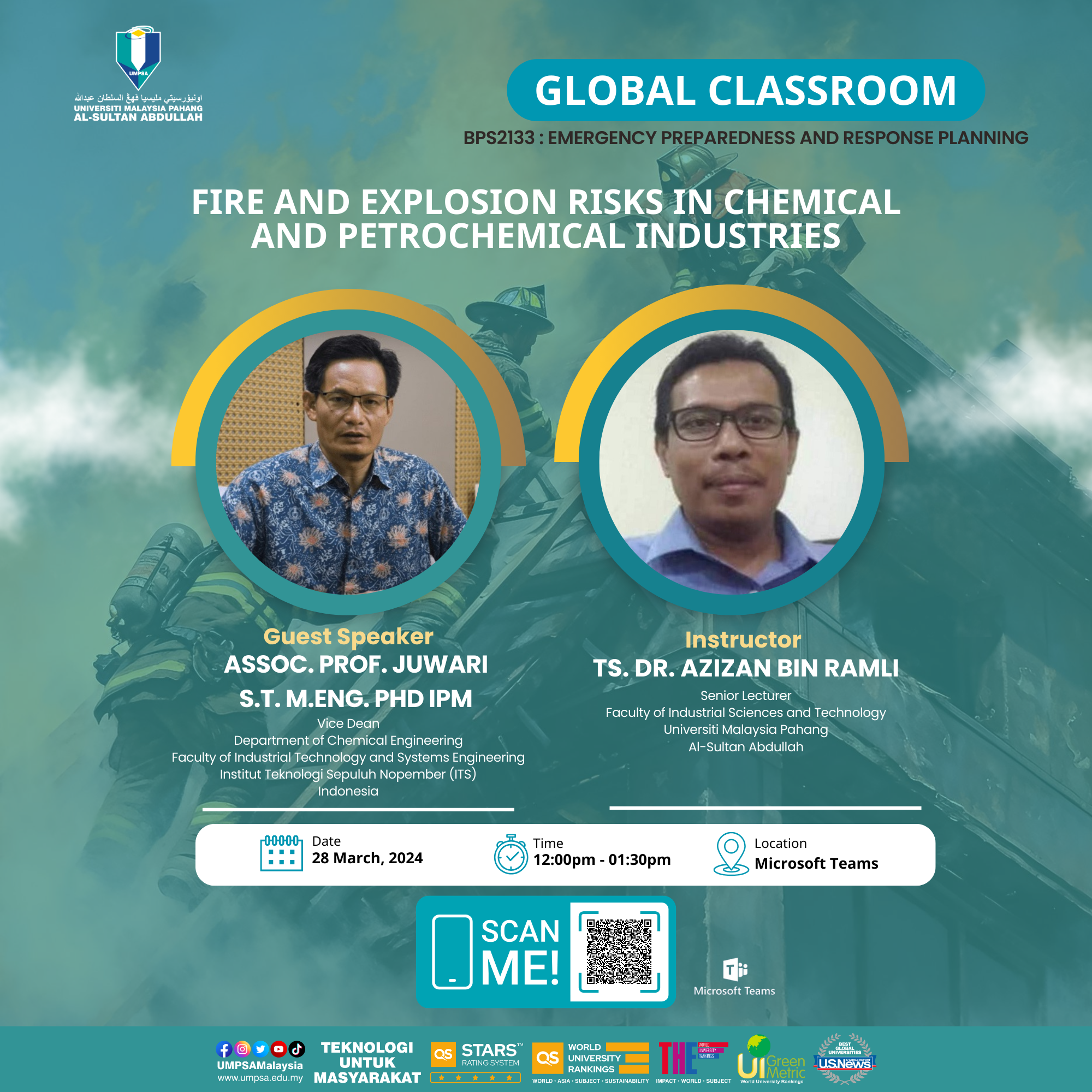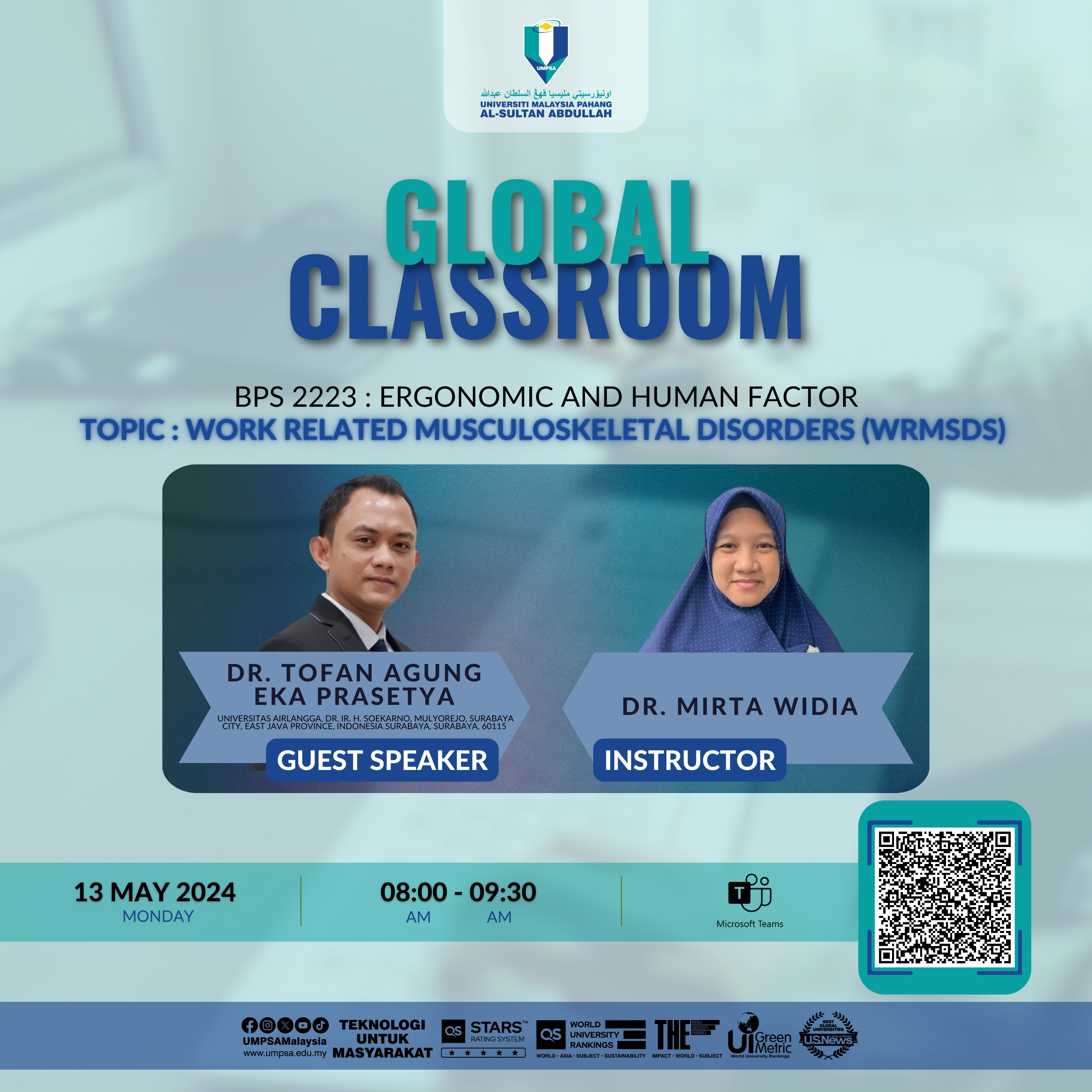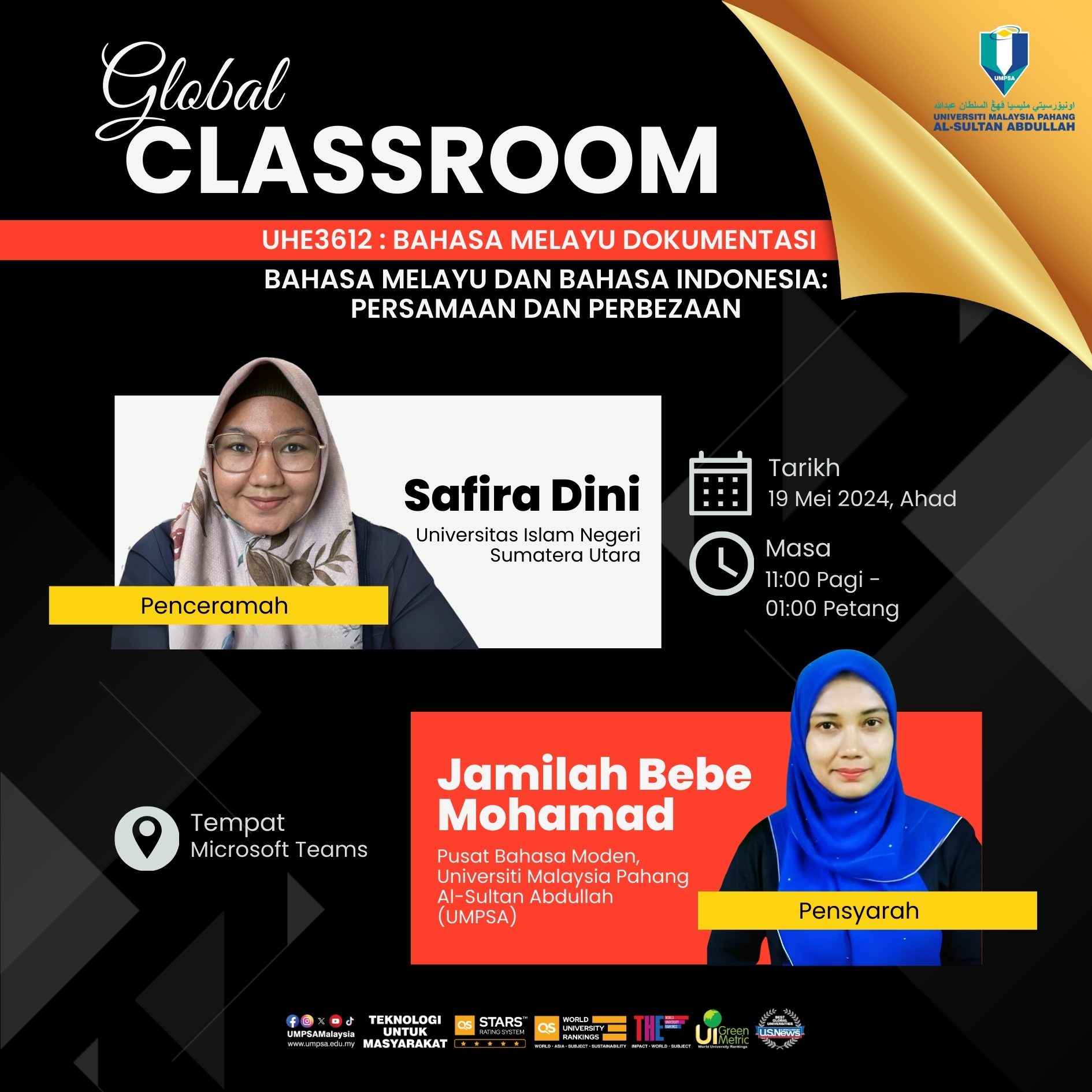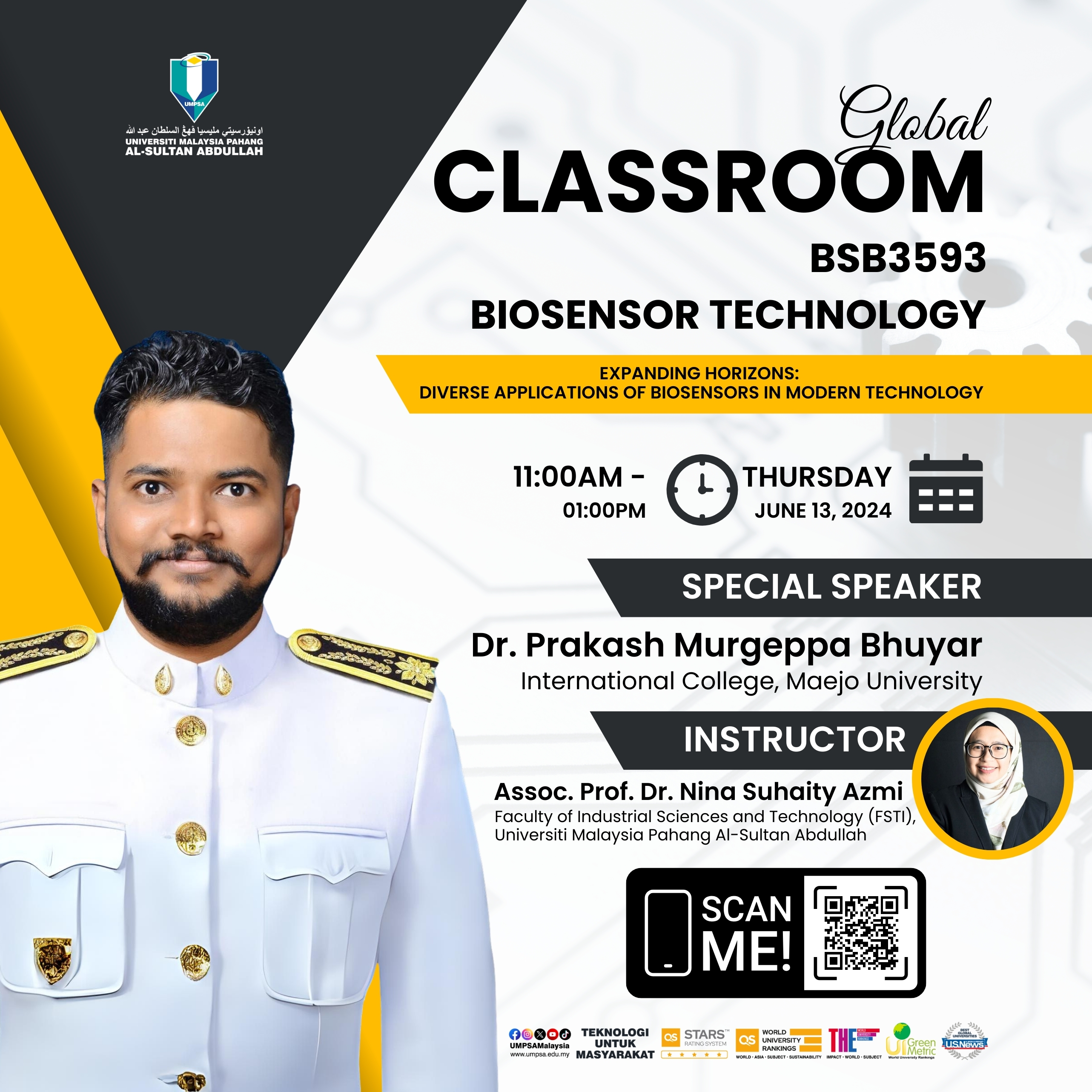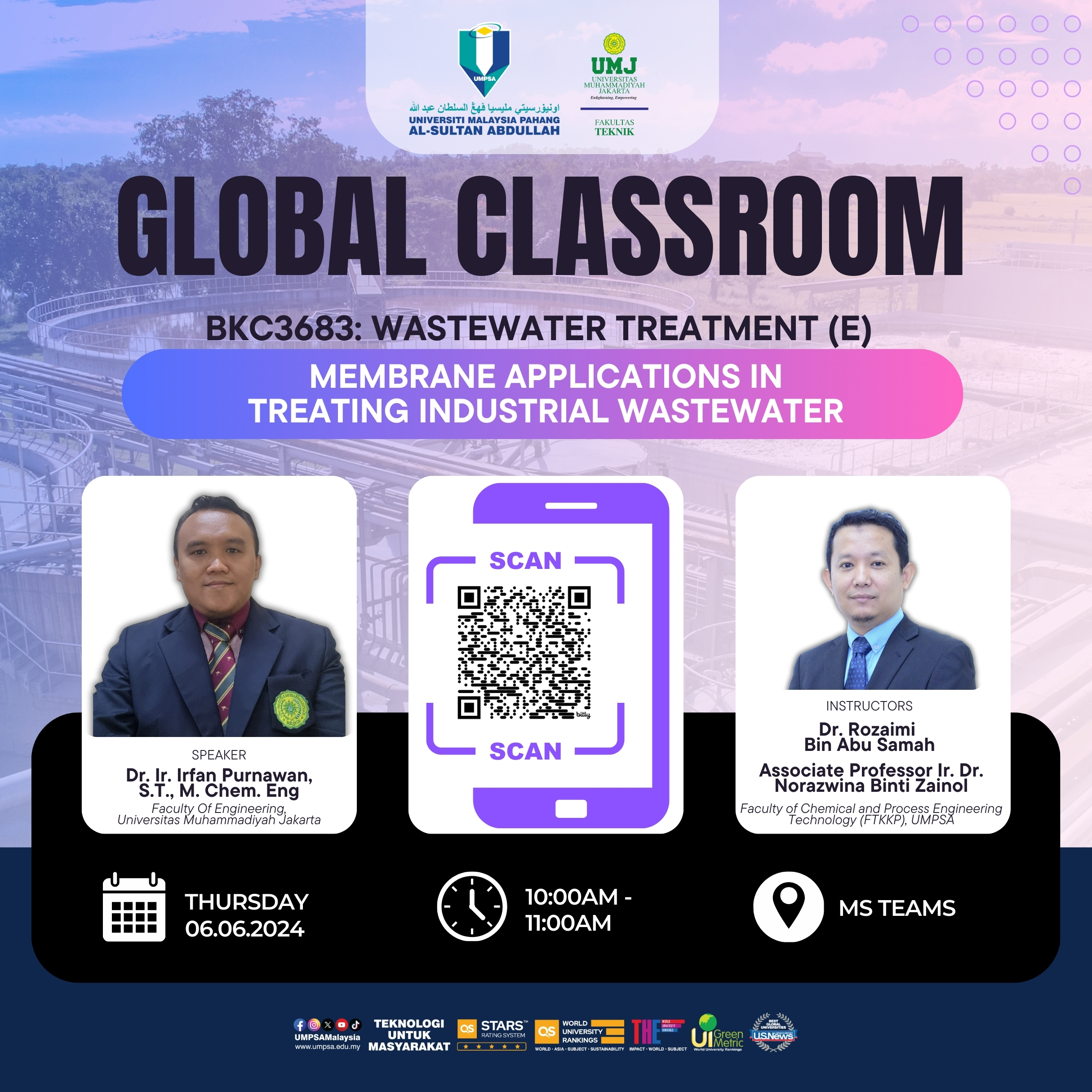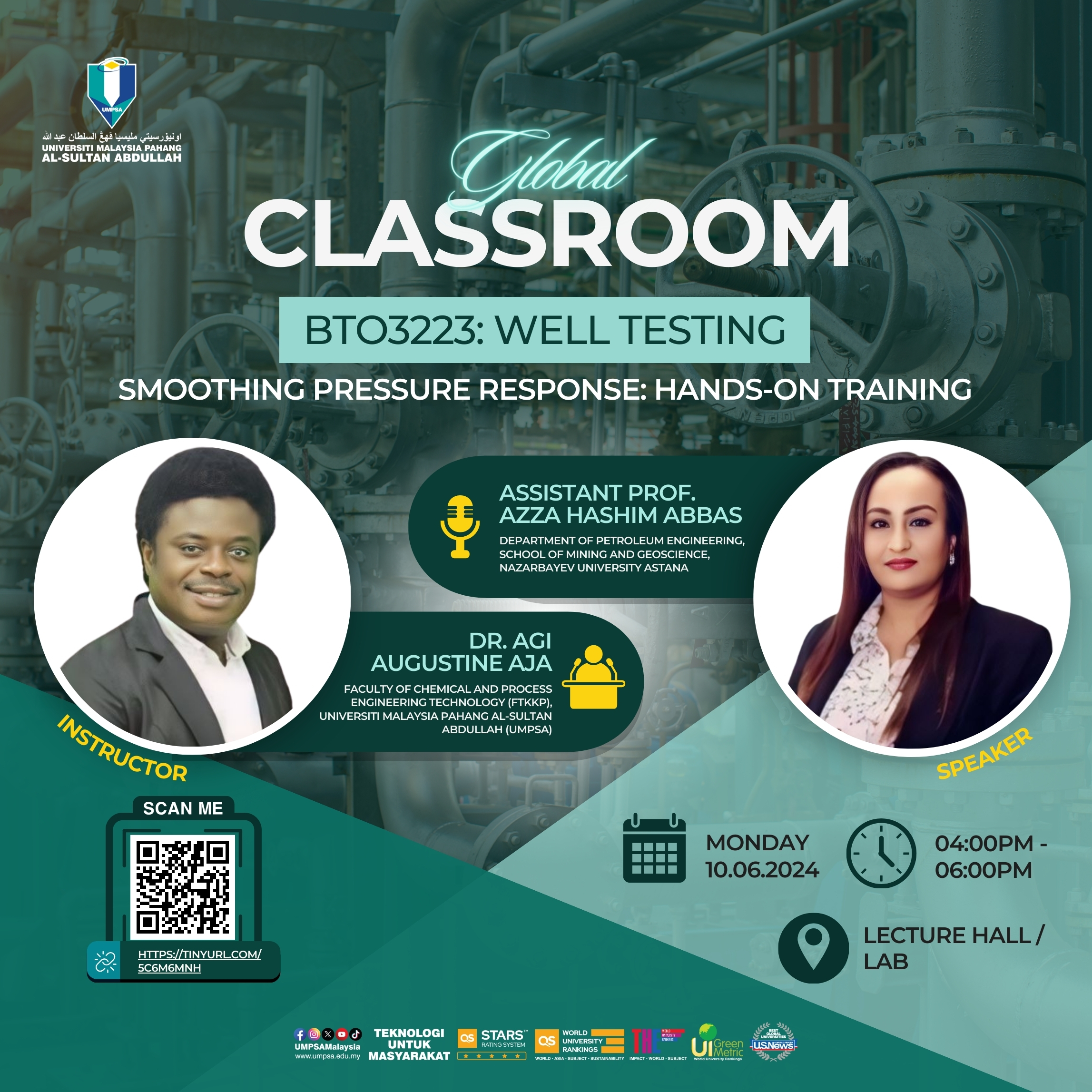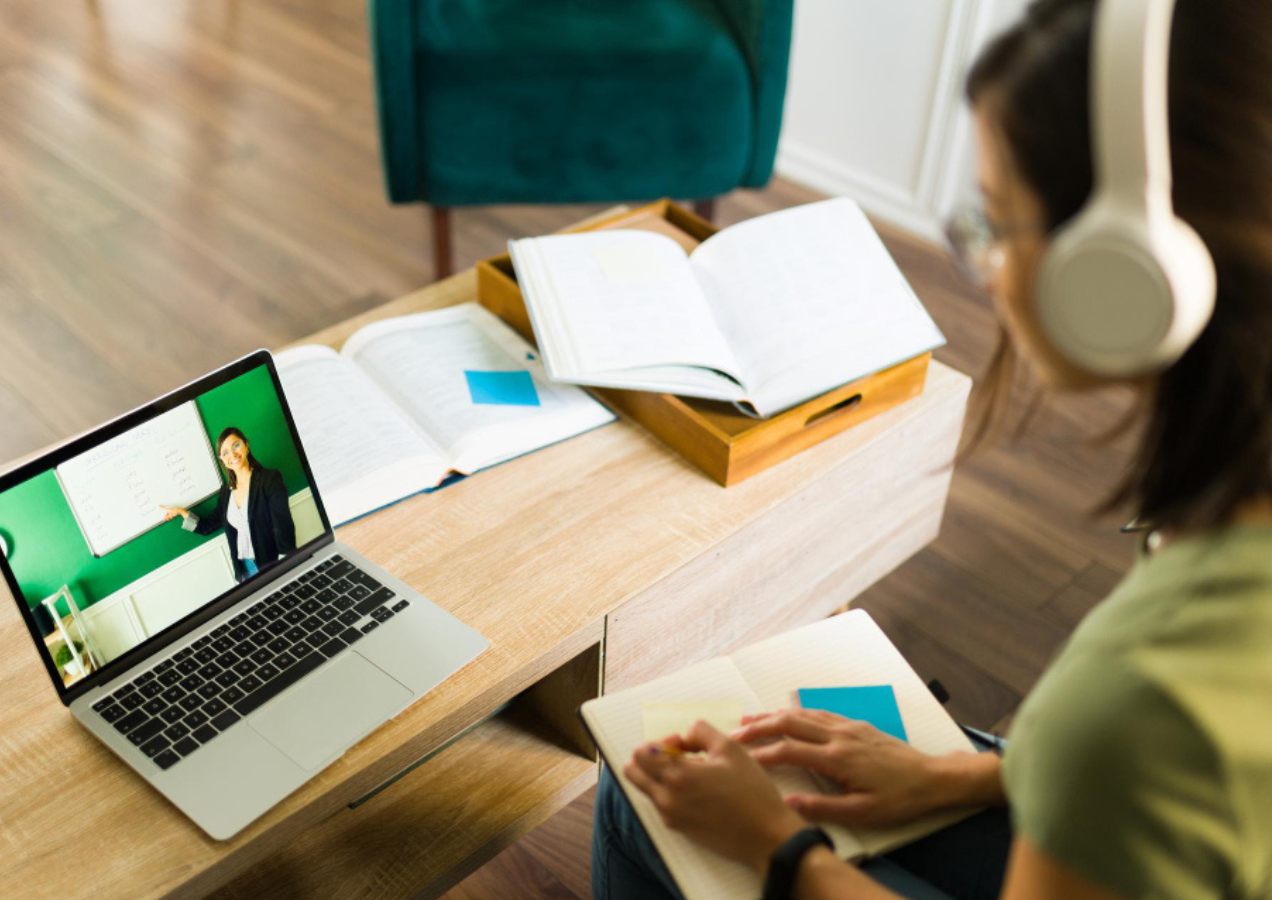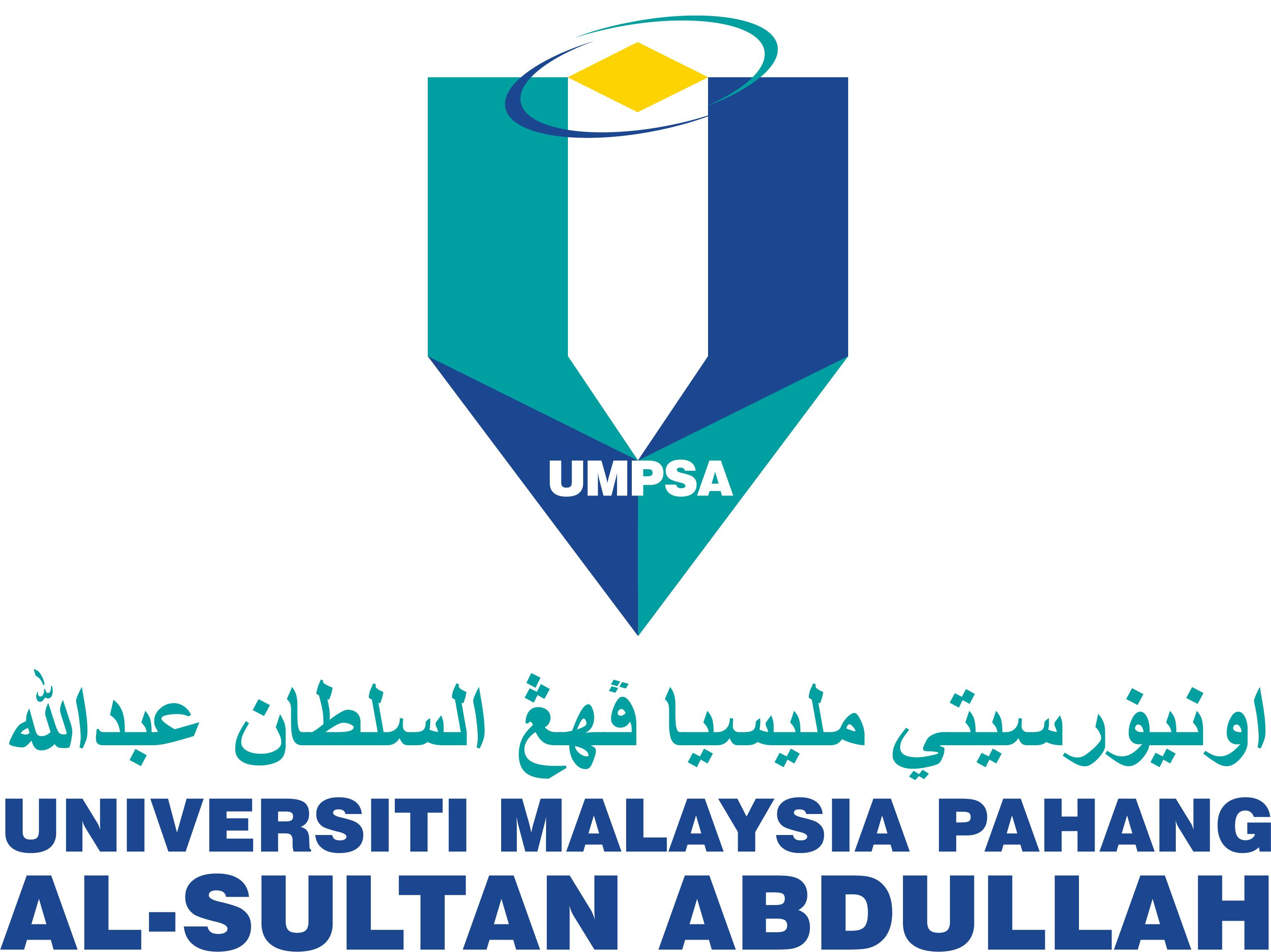Global Classroom
Global Classroom 2025
Global Classroom 2024
Type of GC
2. Standard GC
1. Basic GC
3. Advanced GC
The diverse feature of information and communication technology enables UMPSA to develop suitable pedagogy-technology-learner mix with high added values.
Global Classroom is an active engaged partner program initiated by Centre of Instructional Resources & e-Learning (CIReL) UMPSA. The main target of the Global Classroom is to expand the matrix beyond the conventional physical classroom with integration of online learning platform, flip teaching, long distance education and simultaneous classroom.
Standard Operation Procedure (SOP)and Criteria for Global Classroom Session
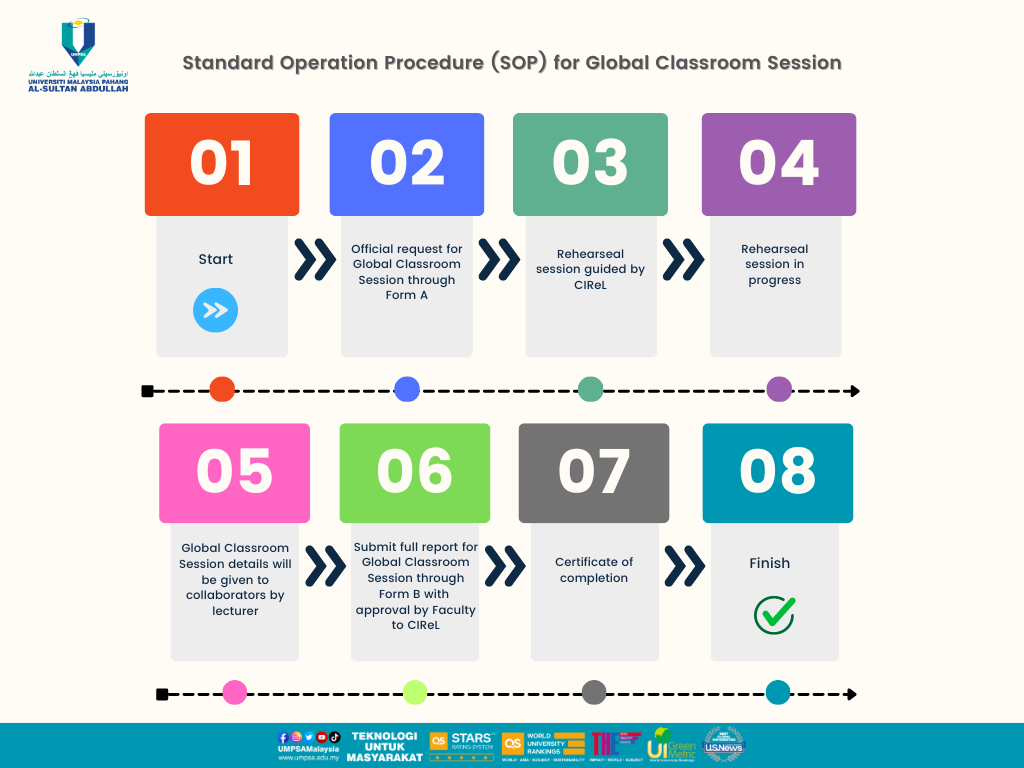

Standard Operation Procedure (SOP)and Criteria for Global Classroom Session
1. Please fill in the (form A) below if you are interested in conducting Global Classroom in your lecture.
2. Submit full report for Global Classroom session (Form B) with approval by faculty to CIReL.
Template Poster

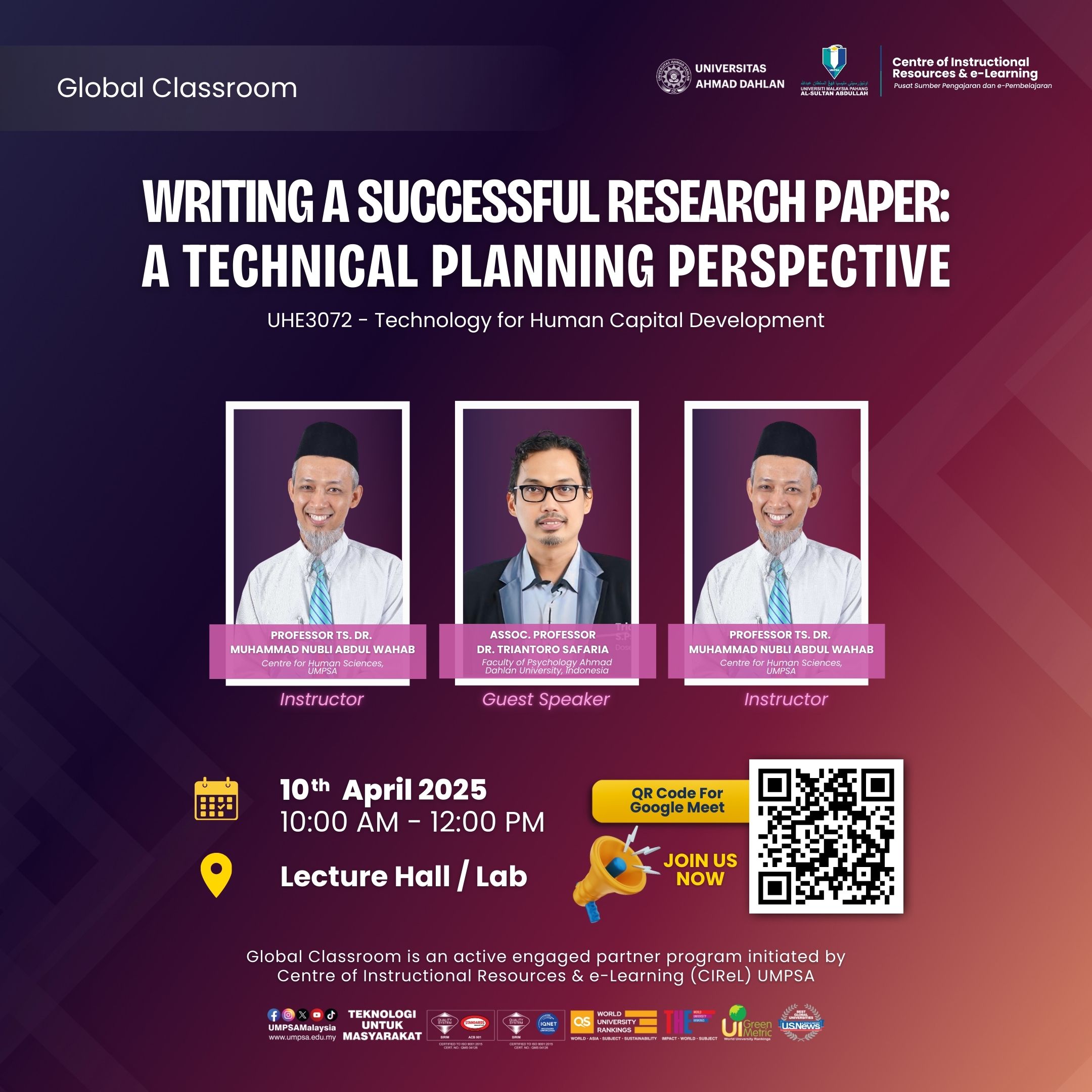

Multinational Industry based in Malaysia
ResMed (Malaysia) Sdn. Bhd
TT Electronics, BI Technologies Corp. Sdn. Bhd
Rock Flow Dynamics
PharmEng Technology
BASF Petronas Chemicals Sdn. Bhd
Sokoine University of Agriculture
Petronas Chemicals MTBE Sdn. Bhd
Cameron Solutions Sdn. Bhd, a Schlumberger Company
Hager Engineering (M) Sdn. Bhd
CJ Bio Malaysia Sdn. Bhd
Fresenius Medical Care Sdn. Bhd
Achievement Global Classroom UMPSA

Frequently Asked Questions (FAQ) for the Global Classroom
1. What is the Global Classroom initiative at UMPSA?
The Global Classroom is an initiative by UMPSA's Centre of Instructional Resources & e-Learning (CIReL) aimed at expanding traditional classroom boundaries through online learning platforms, flipped teaching, distance education, and simultaneous classrooms. It fosters collaborative learning between UMPSA and international universities or industries, engaging instructors and students from both sides.
2. What are the objectives of the Global Classroom?
The primary objective is to focus on providing exposure to UMPSA students, enhancing accessibility, visibility, and learning opportunities from a global perspective. This is achieved through the integration of diverse technologies to develop effective pedagogy-technology-learner approaches with high added value.
3. What types of sessions does the Global Classroom offer?
The Global Classroom offers three categories: Basic GC, Standard GC, and Advanced GC. Each category varies in terms of complexity, the percentage of collaborative learning, and assessment integration:
a. Basic GC:
• GC Index: Average.
• Collaborative Learning Activity/Material: 10% of total Student Learning Time (SLT).
• Learning Assessment: None.
• Total Collaborative Learning SLT: 10% of total SLT.
• Suitable for introductory-level collaboration with minimal integration.
b. Standard GC:
• GC Index: Good.
• Collaborative Learning Activity/Material: 20% of total SLT.
• Learning Assessment: Includes a minimum of 10% collaborative learning assessment.
• Total Collaborative Learning SLT: 30% of total SLT.
• Designed for moderate-level collaboration with integrated assessments.
c. Advanced GC:
• GC Index: Excellent.
• Collaborative Learning Activity/Material: 40% of total SLT.
• Learning Assessment: Includes a minimum of 20% collaborative learning assessment.
• Total Collaborative Learning SLT: 60% of total SLT.
• Best suited for highly complex collaborations with extensive integration and assessment.
4. Who can participate in the Global Classroom?
Both UMPSA instructors and students, as well as their counterparts from international partner universities or industries, can participate.
5. How can I participate in a Global Classroom session?
Here’s how you can participate:
a. Fill out Form A (https://form.jotform.com/222552944148055) to show your interest.
b. Get your faculty’s approval.
c. After the session, submit a report using Form B (https://form.jotform.com/223028434333448), approved by your faculty, to the CIReL office.
6. Does the collaborator or industry speaker need to mark all student assessments for Standard/Advanced Global Classroom?
No, the collaborator or industry speaker does not need to mark all assessments. A sample marking is sufficient for benchmarking purposes. This approach allows for a comparison of marking standards with external experts while the lecturer completes the rest. The session is considered complete as long as the sample marking is done, and Form B can be submitted.
7. Where can I find the necessary documents for the Global Classroom?
The Global Classroom document can be accessed via this link: https://cirel.umpsa.edu.my/media/attachments/2025/02/27/global-classrom-2025.pdf
Or on the portal:
https://cirel.umpsa.edu.my/index.php/en/e-learning/initiatives/global-classroom
8. Can Global Classroom sessions be customized for different courses?
Yes, sessions can be tailored to fit the specific needs and objectives of various courses.
9. Who can UMPSA collaborate with for Global Classroom sessions?
• Allowed: International universities (overseas) and international companies (overseas or in Malaysia).
• Not allowed: Local universities and Malaysian companies.
10. What support does CIReL provide for Global Classroom sessions?
CIReL offers guidance, resources, and support to facilitate the planning and execution of sessions.
11. Can Global Classroom sessions be recorded?
Yes, sessions can be recorded, and recordings are provided to implementers and collaborators.
12. Is there a certificate of completion for participating in a Global Classroom?
Yes, the UMPSA instructor, as well as the collaborators, receive a certificate upon completion of the session.
13. Can lecturers from different courses claim Annual Work Target (AWT) for a collaborative Global Classroom session?
Yes, if students from different courses benefit from the session, all collaborating lecturers can claim it for their AWT.
14. How does the Global Classroom benefit students and instructors?
Benefits include:
• Exposure to diverse perspectives and teaching methods
• Enhanced digital literacy and online collaboration skills
• Opportunities for international networking and partnerships
These advantages contribute to a richer educational experience.
15. Where can I find more information or assistance regarding the Global Classroom?
For more details, visit the Global Classroom page on the CIReL website or contact CIReL directly through their contact information provided on the site.
16. Is the Equivalency Rule still applicable in 2025?
No. Starting in 2025, the equivalency rule (1 Standard GC = 3 Basic GC, 1 Advanced GC = 2 Standard GC) is no longer applicable.

